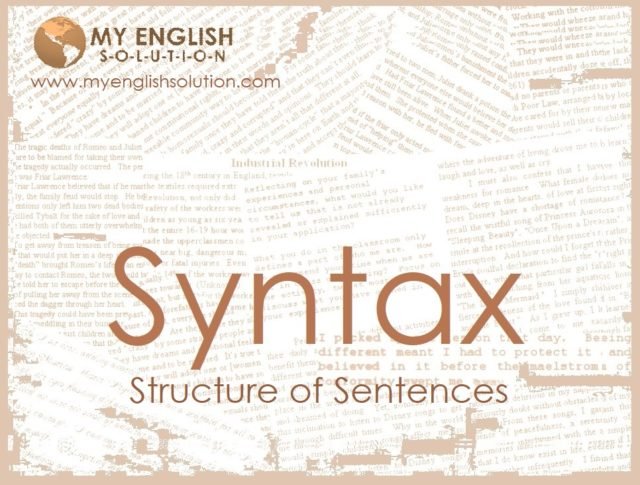| WHAT IS SYNTAX? |
| Syntax is defined as a “branch of linguistics which studies the structure of sentences.” The word ‘syntax’ has its origin in Greek and literally means ‘putting together’ or ‘arrangement.’ Hence, it studies the structure and order of components within a sentence. |
| A sentence is the centre of the study of syntax. A sentence is a meaningful combination or arrangement of words, phrases & clauses. Words are the basic building blocks of sentences. In combination with other words, they form phrases to modify the meaning of the word. Different phrases come together to form a clause or clauses. And a clause or clauses come together to form a sentence. Hence, the study of syntax implies the study of all these components i.e., words, phrases, clauses & sentences along with the rules and principles that govern their coming together meaningfully. |

| WORDS |
A word is a minimal unit in a sentence. It combines with the other word to add meaning to the word. Words in a sentence have different roles to play and they are also identified with different categories. They are: …. Noun (N): refers to a person, place, activity, thing or quality e.g. boy, girl, balloon, ideas, ice cream, candy, basketball, dam, exam etc. Pronoun (Prn): replaces noun e.g. I, me, we, we, us, you, he, him, she, her, it, they, them etc. Verb (V): denote action and tense e.g. eats, likes, play, pass, build, turn, write, attack, fall, burglarized etc. Adjective (Adj): modifies nouns e.g. happy, big, colourless, green, wonderful, erudite, tall, beautiful etc. Adverb (Adv): modifies verb or action e.g. carefully, slowly, very, never, again, luckily etc. Determiner (D): fixes or delimits the meaning of the noun e.g. a, the, one, this, that etc. Preposition (P): indicates the position or lace of a noun e.g. at, about, for, on, in onto, under, etc. |
| PHRASES |
A phrase is a meaningful group of words. Let’s consider an example- the word ‘sparrow’ indicates thousands of birds in the category of sparrows. If we add article ‘a’ before it like ‘a sparrow’ it indicates one among thousands of sparrows. With the addition of ‘the’ like ‘the sparrow’ means a specific sparrow that is known. Hence, the words come together to modify meaning & form a phrase. If we add a word from each of the word categories, their combination will give meaning to the string of the words. …. This exemplifies how words of different categories can be arranged to form a sentence. However, we cannot put the word order in any random way. If we put the sentence like: ‘Slowly flies the happy sparrow’, it still makes sense. Nevertheless, the other possibilities of altering word order may be nonsensical or meaningless. For example: ‘Happy flies slow sparrow’ or ‘sparrow happy slow the flies’. …. Therefore it is important to know that a phrase is not just a string of words but each phrase has its internal structure and sense group. |
| Phrase Types:
Each phrase has more than one word. Among them, one word is the ‘head word’. Words other than the ‘head word’ modify the meaning of the ‘head word’. The type of the phrase is determined by the category of the ‘head word’. In the example given earlier, the word ‘sparrow’ is the headword. The remaining words like ‘the’ (Determiner) & ‘happy’ (Adjective) are modifiers.
|
| Phrase Structure Rules:
As said in the beginning, syntax studies rules and principles of words combining together. Here are some Phrase Structure Rules: Noun Phrase: (NP) (*Because the last one includes all the possibilities of the Noun Phrase Structure, it can generate all possible Noun Phrases. And hence this is the structure of the NP. Same is the case of the following.) Adjective Phrase: (AdjP) Adverb Phrase: (AdvP) Prepositional Phrase: (PP) |
| CLAUSES |
| A clause is a unit of a language which consists of a NP and a VP. e.g. The sparrow flies. When a clause makes sense on its own, it is a sentence. In the Phrase structure rule, it is put like In a variety, it can also be Some clauses do not stand independent and have to join the other clause for meaning. At the level of the sentence, both of the above make a single sentence consisting of an NP+VP (Comp) NP (Aux) VP |
| SENTENCES |
| In English, the verb is considered as centre. There is no sentence without a verb. And for meaning, a verb must have a noun phrase as a subject, object or both.
Subject & object, both consist of NPs The general structure of the English consists of Sub + Verb+ Obj / Complement pattern. Here, Subject and Object or complement is essentially a NP with all the possible PS rules cited earlier. Subject-verb concord: In English, the form of the verb changes in accordance with the Subject it represents. Depending upon the number of dependent clauses in a sentence, sentences can be structurally classified as Simple, Compound and Complex sentences. However, there can be Functional Classifications too like Questions (Interrogatives ), (Imperatives), Tag questions, and Negative sentences. |
also see
| PHONETICS | MORPHOLOGY |
| SEMANTICS | USEFUL SPEAKING EXPRESSIONS |
| DAILY GRAMMAR WORKSHEETS | GRAMMAR_1 |
| GRAMMAR_2 | WORD FORMATION PROCESSES |


















































